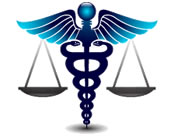

Medical Malpractice Connections

-
Surgical Negligence
- Adrenalectomy (Removal of Adrenal Gland)
- Adjustable Gastric Banding
- Appendectomy (removal of the appendix)
- Cholecystectomy (removal of gallbladder)
- Colectomy (colon resection)
- Common bile duct exploration
- Diagnostic Laparoscopy
- Enterectomy (small bowel resection)
- Enterolysis (removal of scar tissue in the abdomen)
- Esophagectomy (removal of esophagus)
- Fundoplication (surgery for heart burn)
- Gastrectomy (removal of the stomach)
- Gastric bypass
- Gastric Sleeve
- Hepatectomy (resection of portion of the liver)
- Hernia repair
- Hiatal Hernia Repair
- Pancreatectomy (removal of portion of the pancreas)
Esophagectomy (removal of esophagus)
The Condition
Removal of the esophagus is usually performed for a tumor or cancer of the esophagus. If the tumor has not spread beyond the esophagus, then usually the best treatment is to remove the esophagus.
Symptoms
- Difficulty swallowing
- Painful swallowing
- Weight loss
- Heartburn (this can be present for years)
- Spitting up saliva with or without blood
Esophagectomy
This procedure typically is done by operating in both the chest and abdomen and can be performed both open and minimally invasive. For the open approach a large incision is required that involves both the chest and the abdomen. For the minimally invasive surgery approach the procedure requires inserting ports (nozzles) into the chest for passage of a laparoscope and surgical instruments. The laparoscope looks like a telescope with a light and camera on the end so the surgeon can see inside the chest. The thoracic surgeon will insert a laparoscope and instruments into the chest, and free up the esophagus. After the esophagus is free within the chest, the stomach is freed up by inserting the ports in the abdomen. The stomach then will be pulled into the chest to serve as a replacement organ for the esophagus, so that the patient will be able to eat and drink normally. The patient will also have an incision in the neck where the surgeon will connect the stomach (which has been pulled up from the abdomen) to the remnant of the esophagus. After all this has been accomplished, the surgical sites are closed with sutures or staples, or covered with glue-like bandage and steri-strips. The surgeon may also place some temporary tubes: (1) a feeding tube (pencil-thin) in their small bowel, which comes out of the left side of the abdomen; and (2) a chest tube, which comes out of the chest.
Nonsurgical Treatment
Sometimes their doctors may recommend that the tumor is treated with radiation and chemotherapy before having surgery. If the tumor has spread beyond the esophagus, then surgery to remove the esophagus usually is not indicated. The doctor should discuss treatment options with the patient if this is the case.
Risks
Esophagectomy carries the potential of complications weather performed open or minimally invasive. It can be a very difficult operation for the patient as well as the surgeon, and there are many risks. The primary risks of esophagectomy are:
- Heart attack
- Heart rhythm abnormality
- Pneumonia
- Pulmonary embolism
- Leakage of the connection between the stomach and the esophageal remnant
- Stricture of the connection
- Dying off of the stomach
- Internal bleeding
- Infection of the skin at the incision site
- Infection (abscess) in the chest or the abdomen
- Postoperative ileus (the intestines slow down/stop working for several days)
- Paralysis of vocal cords
- Death (up to 5% of cases, depending on state of health before surgery)
Medical Negligence
The above mentioned risks and complications are known to happen with esophagectomy (removal of the esophagus) and such complications do not necessarily constitute deviation from the medical standard of care. The following examples however may be considered as medical negligence.
- Substandard technique in the construction of the connection between the stomach and the esophagus. This may be the result of stapler failure (malfunction) and/or poor surgical technique.
- Failure to timely diagnose a disruption (leak) from the connection despite clinical evidence of such.
| Top of page |
| Home | Medical Malpractice Attorneys | Medical Experts | Medical Negligence | Services | Statute of Limitations | About Us | Contact Us |